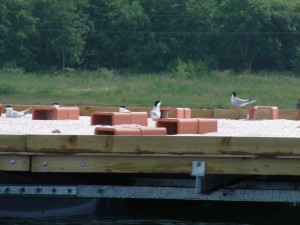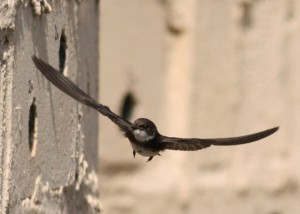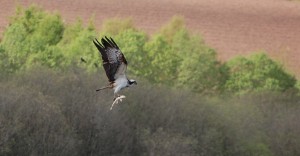Review of 2013 – Part 2
May
May was another month in which thoughts were focused on the return of our summer migrants. Osprey sightings continued to be a regular occurrence throughout the month whilst Sand Martin Numbers steadied at around 30 and Swallow numbers slightly increased from the 2 seen in April to 4. The first Swifts of the year on the reserve were seen on the 19th, with 12 flying past the visitor centre.
Whilst all this was happening, the reserve staff and volunteers were busy rushing around putting in many hours of work to try and make sure that our tern raft was ready for the return of the Common Terns later in the month. With the raft fixed and repaired following damage from last summer’s storms, all that was left to be done was to get the camera working. This, however, was easier said than done, with the camera having been worked on for almost 2 years and still proving problematic. The first Common Terns were spotted on the on the 7th, although they weren’t seen using the raft. The Common Tern numbers didn’t increase much until the 28th of the month, when 40 were seen, this time using the raft. At this point the decision was made to stop any work on the raft to help minimise any disturbance to the terns, thus increasing their chances of nesting successfully.
Other notable sightings on the reserve in May included a Marsh Harrier seen at the Lurgies on the 1st, a Water Rail on the 2nd and a Re-Throated Diver on the 5th. The 5th also proved to be a particularly good day for seeing Warblers here at the Visitor Centre, with no less than 5 species Chiffchaff, Will Warbler, Sedge Warbler, Whitethroat and Black Cap) being seen within the space of a few hours.
June
June started off with some good news regarding the Tern Raft camera, with the Common Terns, initially failing to settle on the raft (something which isn’t unusual) the team were able to get out onto the raft and do some final work on the camera. This resulted in it working properly for the first time in 2 years! It was now just up to the terns themselves to settle, lay their eggs and breed successfully. The only thing stopping this was the presence of 2 Carrion Crows, who seemed to have taken residence on the raft, a great risk to any Terns who decided to lay eggs. Usually the terns are able to drive the crows off if they arrive back in large enough numbers, however the numbers weren’t high enough last summer and they failed to drive the crows off for any long period of time. The few eggs that were laid were taken and eaten by the crows, which also drove the adult terns off the raft. Although this was concerning there was still hope, with eggs laid at the beginning of July still having time to hatch and the juveniles fledged, providing the summer is long and the adults hold their migration off slightly.

Although the Sand Martins were present in smaller numbers than usual they were successfully breeding, with around 15 nests in our wall being occupied and the first chicks being spotted on the 10th of the month. Swallow numbers continued to be low throughout the month, with no more than a few of the nests in our centre eaves being occupied. The same trends were seen across the country with the stormy summer of 2012 and the cold prolonged spring seeming to have their effects on a wide range of species.

July
Ospreys continued to buck the trend of other breeding species in 2013, both here and across the country, with increased sightings and a high number of successful hatchings. On numerous occasions in July here at Montrose Basin, there was more than one Osprey seen on the reserve at one time. This included 4 individuals seen on the 1st and 3 on the 28th.

Unfortunately, the same success never came for our Common Terns, with the time for them to successfully lay and hatch their eggs passing by. Although they continued to be seen around the raft throughout the month and were even seen to be taking part in courting behaviour on the 20th, it was too late for this to be successful. Our Sand Martins had differing fortunes, with most managing to fledge the young from their first brood, however failing to go on and lay a second brood, with the majority of them leaving the wall at the start of the month.
A Water Rail with 2 chicks was seen both at the Lurgies and in front of the Visitor Centre in July, indicating that we had at least 2 successfully breeding individuals on the reserve. We also saw the waders starting to return from their breeding grounds inland, with increased sightings of Redshanks, Dunlin, Black and Bar Tailed Godwits, Greenshank, Common Sandpiper and even a few Green Sandpiper sightings.
Craig Shepherd,
Visitor Centre Assistant Manager.
Help protect Scotland’s wildlife
Our work to save Scotland’s wildlife is made possible thanks to the generosity of our members and supporters.
Join today from just £3 a month to help protect the species you love.
Preface
May May was another month in which thoughts were focused on the return of our summer migrants. Osprey sightings continued to be a regular occurrence throughout the month whilst Sand …
